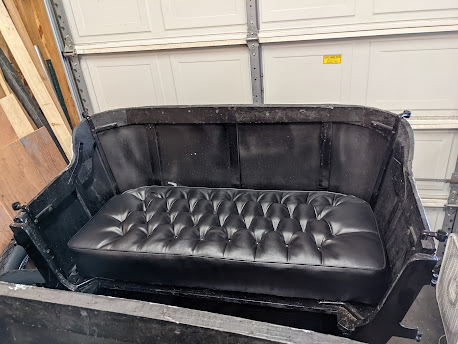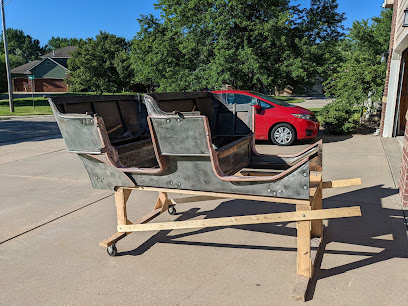With the painting complete, it was time to install the new upholstery and top. They are pretty much the go to company for Model T and Model A interiors now. Fortunately they make very good kits. They come with rather sparse instructions, so it pays to look for online videos and read what you can find on the Model T forum for installation tips. Both the kits come with factory authentic crude looking nails to use for the installation, but I prefer using a pneumatic stapler. I suspect that “Henry” would have used such a stapler if they’d existed during the Model T production, and they make the installation work go much easier. All the staples are hidden if you do the installation correctly, so no one has to know!
The earliest picture of the car from 1923 shows that the original top had been replaced at some point prior to that. That top differed from the factory version by having a glass oval window with a brass frame for the rear window. I had Classtique leave the rear plastic window out of the top kit that they made for the car so that I could reinstall that window. It is the one unique feature that ties the all the pictures of the car through the years together. That replacement top also did not have the ability to roll up the rear top for increased ventilation like the original factory version. The top kit from Classtique did have this feature, so I had to install the oval window into this flap. The oval window is smaller than the original factory plastic window, so I am glad that I would have the option of rolling up this flap for improved visibility.
The upholstery needs to be installed before the installing the top though. Recovering the seat cushions is the first step. The picture below show the seat springs. They looked like something from a century old mattress. Some of the spring coils needed to be reconnected to the braces shown in the picture. Installing the new covers requires compressing the whole cushion while attaching the new seat cover to the wire frame. There is a very good Classtique video on their website showing how to do this with two 2x4 clamps. Once compressed, the cushion is attached to the bottom wire edge using what are called "hog rings", which sort of look like nose piercings you may have noticed some people like to wear. They are crimped using a special tool, which I now have in my toolbox for any future Model T upholstery work or to crimp on any body piercings someone wants me to do for free.
Though introduced in the fall of 1908, the Model T did not come equipped with seat back springs until the 1915 Model year. Since this car is from 1911, that meant that any lumbar support was going to come from the seat back upholstery. The third picture shows what the seat back looked like before the back upholstery was installed, with the fourth picture showing the seat back that is heavily stuffed with a cotton like substance.
Installing the seatback is the most difficult part of the upholstery installation. You need to center the back and start attaching it from the center and chase it around to the end on the left and right side. Installing the top edge requires even more care, as the stuffing needs to be worked to fill out the sleeves between the seams and the edges darted to go around the corners. As I mentioned earlier, a pneumatic staple gun was used instead of the provided primitive nails. I cannot imagine how much hard it would be to install using those. The forward end of each armrest needs to be carefully folded, sort of like wrapping a present. Later Model years had end caps which would make that easier. I had taken a lot of pictures of the original upholstery before removing it so that I saw how the Baudette factory workers installed it in 1911. Baudette was the maker of this car's body, and was one of several former carriage companies that made bodies for the Model T. The last step is installing the trim strip, using black thumbtack looking nails. You can see what the trim strip and tacks look like in the picture showing the rear door interior panel installation. Overall I was very happy with how the upholstery installation turned out, and as it turned out, the seats are pretty comfortable without seatback springs.
Installing the top brings another opportunity to learn long lost skills! My first top installation was on the two seat 1915 Model T that I installed, which was a lot easier because it had only one top bow. Before starting the top installation, I temporarily mounted the body to the chassis frame because the front straps for the top attached to the headlamp forks when the top is up. A secondary benefit of doing it this way is that the body is lower to the ground, so that much of the work could be done while standing on the ground. This was not the case when I installed a new top on our 1921 Model T a few years ago. The body was installed on the car and required using a step ladder to reach the upper areas of the work.
The top bows needed to be wrapped first, which is very difficult because the vinyl type fabric provided does not easily stretch around compound curves. I found that it worked best to start by using spray adhesive to attach the material to the bottom side of the bow and work it around the square wood steam bent bows. Eventually the material needs to have darts cut along the edges to allow them to wrap around to the upper side. These darts are done so that they are on the top portion, and remain hidden after the material is stapled on the top.
The touring cars have two top bows, which need to be kept parallel while installing the top. I used a series of lath strips temporarily hold them in place, along with ratcheting straps. A bubble level and just inspecting visually will help get these located correctly. Once located, the forward to aft straps were located and stapled on the top of the bows, and the corner pads located, stapled to the corner of the bows, padding installed and the upper side sewed together.
Finally it was time to locate, trim and stable down the top. A lot of time was spent getting this located correctly. Although the corner pads are attached to the two middle bows, the top is not. Otherwise the top will tend to tear out the nail or thumbtack used to attach the top to those bows when the top is being put down.
The rear piece of the top is also installed at this time, including installing that pre 1923 brass framed oval glass window. Brass quarter turn fastener are used to secure the rear piece when down, as well as to attach the lower edge of the top to the car. Prior to 1915, the Model T tops could be completely removed if the owner so desired. The tops were permanently attached along the rear bottom edge after that.
The body was now done and it was time to assemble the engine, rear axle. After that, assemble the car and get it on the road!





















































